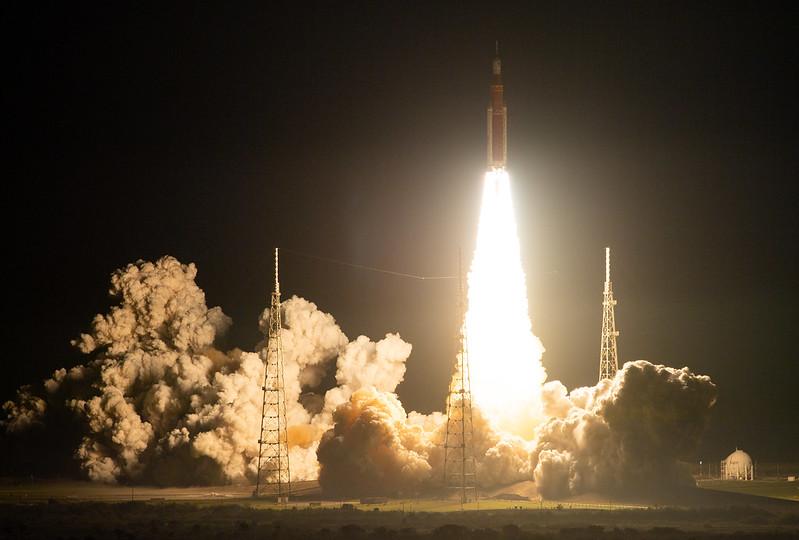Australia on a path to the moon with NASA’s Artemis program
Posted By Malcolm Davis on November 17, 2022 @ 15:15

After two launch scrubs due to fuel leaks and a hurricane, NASA has taken a giant leap back to the moon after almost 50 years’ absence with the successful launch of the Artemis I mission [1] early yesterday morning. The Space Launch System [2] rocket carries an uncrewed Orion spacecraft [3]. The same configuration will be used on Artemis II, a crewed mission to orbit the moon expected to launch in 2024.
Then, Artemis III is tentatively scheduled to make a lunar landing in 2025 (the first since Apollo 17 in 1972), when the first woman and the first person of colour will stand on the lunar surface. The lunar lander will be a version [4] of the SpaceX Starship vehicle.
The Artemis I mission will last 25 days, much longer than the Apollo missions in the 1960s and 1970s. It will travel almost 2.1 million kilometres and make several retrograde orbits [5] of the moon out to 64,000 kilometers beyond its far side. The Orion capsule will then return to earth, re-enter the atmosphere and splash down in the Pacific Ocean on 11 December.
The program goal [6] is to establish a sustainable presence on the moon in an ‘Artemis base camp’, and astronauts will orbit the moon using a space platform called Gateway [7]. Missions will be scheduled roughly once a year after the successful completion of Artemis III. Ultimately, lunar surface missions will last up to two months each for up to four astronauts. That will enable testing of technologies and assessment of the biomedical and physiological requirements for a crewed Mars mission probably by the late 2030s or mid-2040s.
The Australian Space Agency is supporting the Artemis missions through its ‘Moon to Mars’ initiative [8], under which commercial companies provide exploration and logistics support. Australian projects in development include ‘G’Day Moon’, a plan developed with NASA to send an Australian-made lunar rover [9] to the moon, possibly by 2026. Borrowing from the design of autonomous vehicles used in the mining industry, the rover will be semi-autonomous and controlled from earth. Its mission will be to collect samples of the fine grey lunar soil known as regolith [10], with the aim to extract oxygen from it to sustain a base or for use as rocket fuel for deeper space exploration. This is a key step in establishing a permanent human presence on lunar bases and supporting future Mars missions.
Meanwhile, Adelaide-based Fleet Space Technologies’ Seven Sisters [11] initiative is working on the deployment of satellites to lunar orbit from 2023 to support the search for resources. The search will involve surface arrays and rovers examining the lunar subsurface and drilling in areas of interest. The project [12] will see Australian hardware using space resources and sustaining a human presence on the surface.
An agreement might ultimately be reached with NASA for Australian astronauts to fly on moon missions alongside US and other international partners—an inspiring option for young Australians seeking a career in space.
Australia’s support for a return to the moon with its development of a vibrant commercial space sector is a very positive step that merits strong support from the Australian and US governments. Relying on taxpayers to do everything from building rockets to training astronauts is yesterday’s approach. NASA has correctly recognised the value of public–private partnerships and is contracting out key elements of Artemis to commercial companies, notably the human lander system to get astronauts down to the lunar surface. Australia must take the same approach.
Australia has come a long way from the days of passive dependence on others to provide our space capability. Merely providing ground support and analysis of data isn’t enough for Australia as a new space power. Most leaders in the Australian space sector, in government, in the commercial sector and in defence have shown a determination to move forward—and upward. That’s vital if Australia is to succeed in space.
Australia’s space agency is leading development of a new national space policy [13] that brings together the 2019 civil space strategy [14]and Defence’s 2022 space strategy [15]. The policy needs to prioritise opportunities for local companies, including helping space start-ups participate in Artemis. The ‘Moon to Mars’ initiative must aim for substantial direct Australian involvement in Artemis through commercial companies supporting activities on and around the moon. As Australia moves towards establishing sovereign launch capabilities, companies such as Gilmour Space Technologies [16] are developing rockets to be launched from sites such as Nhulunbuy in the Northern Territory, Whaler’s Way in South Australia and Bowen in Queensland. Establishing this national infrastructure and sustaining the growth of our commercial space sector increases the potential for more rapid and expansive Australian participation on and around the moon.
A clear space policy goal should be to see Australian companies launching payloads—and eventually people—to the moon to directly support NASA. That support will encourage the US to sustain its lunar program as it and its partners face increasing competition from potential rivals such as China in this decade and into the 2030s. China’s lunar ambitions are growing and Beijing is establishing the technological capability for its own crewed missions.
The US, and Australia, must not let history repeat itself by again turning away from the moon.
Article printed from The Strategist: https://aspistrategist.ru
URL to article: /australia-on-a-path-to-the-moon-with-nasas-artemis-program/
URLs in this post:
[1] Artemis I mission: https://twitter.com/NASA/status/1592772202289430528?s=20&t=wMzZ687J8SmcukeWG-24cg
[2] Space Launch System: https://www.nasa.gov/exploration/systems/sls/index.html
[3] Orion spacecraft: https://www.nasa.gov/exploration/systems/orion/index.html
[4] version: https://www.spacex.com/updates/#starship-moon-announcement
[5] retrograde orbits: https://www.nasa.gov/sites/default/files/thumbnails/image/artemis_i_3_28_22.jpg
[6] goal: https://www.nasa.gov/specials/artemis/
[7] Gateway: https://www.nasa.gov/gateway
[8] initiative: https://www.industry.gov.au/news/moon-mars-initiative-launching-australian-industry-space
[9] lunar rover: https://www.industry.gov.au/news/gday-moon-australias-boldest-adventure-yet
[10] regolith: https://curator.jsc.nasa.gov/lunar/letss/regolith.pdf
[11] Seven Sisters: /seven-sisters-project-taking-australia-further-into-space/
[12] project: https://www.7sisters.com.au/
[13] national space policy: https://www.theaustralian.com.au/special-reports/unified-space-strategy-update-to-shape-defence-space-rd/news-story/ad45871956260afd722583d6001ddf54
[14] 2019 civil space strategy : https://www.industry.gov.au/publications/australian-civil-space-strategy-2019-2028
[15] 2022 space strategy: https://www.airforce.gov.au/our-work/strategy/defence-space-strategy
[16] Gilmour Space Technologies: https://www.gspacetech.com/
Click here to print.